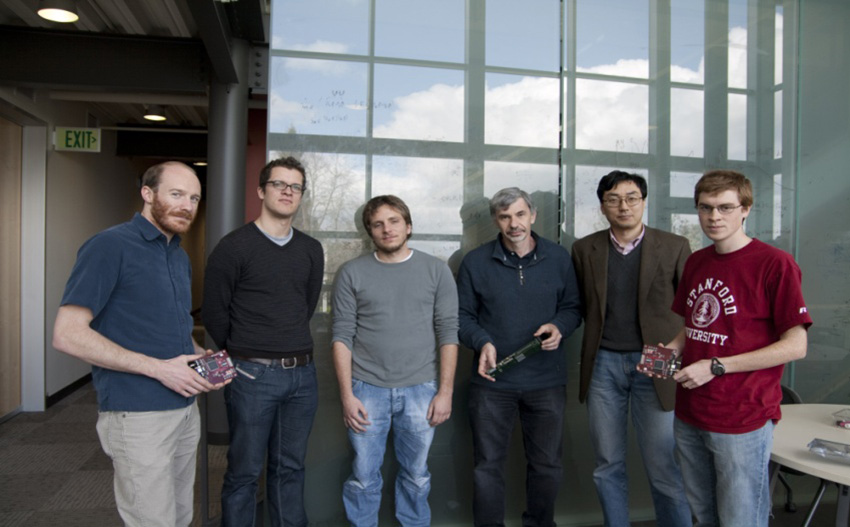Prototype Detector and Chip Technology
Photo by Julie Karceski, SLAC National Accelerator Laboratory
From left: Justin Vandenbrouke, Stefan Funk, Rolf Buehler, Leonid Sapozhnikov, Hiro Tajima, and Keith Bechtol hold electronic chips they developed for improved gamma ray telescopes.
Researchers at the Kavli Institute for Particle Astrophysics and Cosmology, a joint institute of the SLAC National Accelerator Laboratory and Stanford University, have developed a prototype detector and chip technology that promise to improve the sensitivity and resolution of ground-based gamma-ray telescopes while decreasing costs to allow deployment of large telescope arrays.
Why it Matters
Gamma rays are traces of the most energetic events in the universe, from the collapse of giant stars into black holes to collisions of cosmic rays with intergalactic gas, and possibly even the explosive annihilation of dark matter particles with their antimatter counterparts. Because gamma rays do not penetrate Earth’s atmosphere, researchers must study these events by launching a gamma telescope into orbit or deploying ground-based detectors to catch the brief flashes of light emitted when gamma rays collide with atoms in the atmosphere. The more thoroughly these events are detected, the more information astrophysicists can reconstruct about crucial events in our universe.
Methods
Currently, there are four ground-based gamma-ray telescope systems staggered across the globe from Namibia, Africa to the Canary Islands. Each location has between two and four telescopes. Researchers hope to one day boost that number to as many as 100 instruments to provide a much more detailed picture of gamma-ray events with broader coverage of the sky and more exact localization of gamma signals.
To separate the short-lived optical light emitted by gamma-ray collisions in the atmosphere from the background light of stars and cities, scientists need a camera that can capture extremely short exposures—on the order of only a few nanoseconds (billionths of a second)—so the camera’s detector must be fast. It must also be extremely sensitive to detect and amplify a signal from only a few photons. The camera must interpret the incoming signal, convert it into a digital readout, and store that readout on a computer, all very quickly. The system must be inexpensive to enable construction of large arrays. The project team is finding ways to sharpen camera sensitivity and cut costs at each of these critical steps by developing a new light-detection device and an improved electronic chip for digitizing the light pulse.
What’s Next
Reduced cost and improved performance will enable construction of the Cherenkov Telescope Array, a system of up to 100 telescope that will serve as an open observatory to the astrophysics community. With multiple high-resolution telescopes spread over an area of 10 square kilometers, it will provide a more detailed view of high-energy phenomena from stellar scales to the subatomic within and outside our galaxy.
Acknowledgments
SLAC National Accelerator Laboratory team members include Keith Bechtol, Justin Vandenbroucke, Akira Okumura, Leonid Sapozhnikov, Hiro Tajima, Seth Digel, and Stefan Funk of the joint SLAC/Stanford University Kavli Institute for Particle Astrophysics and Cosmology; Gary Varner at the University of Hawaii; and Jim Buckley at Washington University.
Publication
Bechtol, Funk et al., “TARGET: A multi-channel digitizer chip for very high-energy gamma-ray telescopes” (http://arxiv.org/abs/1105.1832)



